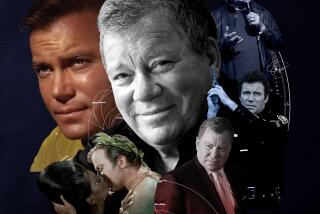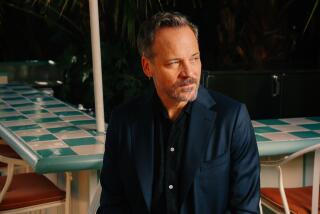Astronomer Sagan Dies; Helped Popularize Science
- Share via
Carl Sagan, the astronomer equally at home studying the universe, writing best-selling nonfiction and fiction, teaching standing-room-only science classes or beaming into the nation’s living rooms to make “cosmos” an exciting household word, died Friday. He was 62.
The multifaceted scientist and communicator died of pneumonia at the Fred Hutchinson Cancer Research Center in Seattle. He underwent a bone marrow transplant there in 1995 and became a regular visitor to the facility for treatment of his rare disease called myelodysplasia, or pre-leukemia syndrome.
The scientist lived in Ithaca, N.Y., where he was Cornell University’s David Duncan Professor of Astronomy and Space Sciences and director of the Laboratory for Planetary Studies.
Sagan was proud of popularizing science, which he did with more than two dozen books, hundreds of articles and lectures and a 1980 Public Broadcasting Service television series labeled simply and majestically “Cosmos.” He so well positioned himself as the affable and engaging scientist next door that he was welcomed 25 times to Johnny Carson’s “Tonight Show.”
“I think he was the leading scientist on Earth in the efforts to inquire about extraterrestrial life,” said Louis Friedman, president of the Planetary Society, which Sagan co-founded. “In addition, he was singular in his ability to convey the joy and wonder of exploring other worlds to people anywhere. He occupied a niche that few others do; he conveyed science to the public.”
*
Neal Lane, director of the National Science Foundation, called Sagan “a true pioneer and an American hero . . . a truly civic scientist.”
“While he conducted ground-breaking research in planetary science, he also conducted a one-man campaign to increase public understanding of science,” Lane said. “Sagan understood the need to bring science into American living rooms, to show its relevance to our everyday lives and to share the excitement of discovery.”
As a research scientist looking into space, Sagan concluded through experimental models as a doctoral student that Venus had a surface temperature of 900 degrees, so it was considerably less hospitable than many scientists believed. He was one of the first to determine that life could have--and probably had--existed on Mars. He dislodged the long-held theory that canals and seasonal vegetation existed on the red planet, establishing instead that fierce winds and dust storms caused its light and dark spots.
Sagan was a pioneer in the emerging field of exobiology, the study of the possibility of extraterrestrial life, and continually prodded NASA to extend exploration of the universe.
He was a distinguished visiting scientist at the Jet Propulsion Laboratory in Pasadena and helped design and manage the Mariner 2 mission to Venus, the Mariner 9 and Viking trips to Mars, the Voyager mission to the outer solar system and the Galileo mission to Jupiter.
Arousing some complaints that he was “sending smut into space,” Sagan co-designed plaques for some of the robotic vehicles stating a time and place of their launch and including pictures of the launching species--a nude man and woman.
Torrence Johnson, Sagan’s Galileo colleague at JPL who also worked with him on the Voyager missions to Jupiter, Saturn, Uranus and Neptune, said Friday: “Carl was one of the greatest intellects behind the genesis of space exploration generally and specifically the Galileo mission. . . . He was a great human being who shared with everyone his excitement about the exploration of the universe.”
Dan Goldin, administrator of NASA, noted that Sagan was an early champion of having the United States and Russia work together in the exploration of space and praised Sagan’s “unbelievable ability to explain the complexities of space and space exploration [which] inspired people to look up into the night sky in wonder.”
As a writer, Sagan won the Pulitzer Prize for general nonfiction for his 1977 book “The Dragons of Eden: Speculations on the Evolution of Human Intelligence.”
Many of his books, which had widely ranging topics, found their way to the bestseller lists. “Cosmos,” the book tied into his television series, topped one list for 70 weeks. Applying his scientific research and reasoning to fiction, Sagan scored more success with such works as “Contact,” a novel about the discovery he envisioned of radio signals from outer space. For 12 years, he also edited Icarus, the leading professional journal on planetary research.
*
As a television personality, Sagan sparkled. He became one of the world’s most recognized scientists when his Carl Sagan Productions and KCET-TV Channel 28 in Los Angeles co-produced the $8-million, 13-part series for PBS. The comprehensive series, co-written by Sagan’s third wife, Ann Druyan, won a Peabody Award and three Emmys. The epic dealt with the origin of life and the evolution of galaxies, matter and the human brain.
Early critics denounced what they viewed as Sagan’s pedantic soliloquies, but the series gained popularity and critical acclaim as it progressed and has been repeated many times in the last 15 years. Seen by some 400 million viewers worldwide, it was the most-watched limited series in the history of American public television until “The Civil War” aired in 1990.
As Sagan became a familiar face on Carson’s show in the 1970s, he attracted a following of autograph hunters and swooning women. New York magazine rated his appearances “one of the great reckless solos of late-night television.”
As an advocate for nuclear disarmament, Sagan protested against nuclear weapons testing (and was arrested) and penned articles for newspaper opinion pages across the country, including those of The Times. He worked to warn humankind that any nuclear war would bring radiation poisoning and “nuclear winter,” possibly extinguishing the species.
Sagan was born Nov. 9, 1934, in New York City, the son of Russian immigrant cloth cutter Samuel Sagan and homemaker Rachel Gruber Sagan. Although his parents were not scientists or even college educated, they encouraged their son to research answers to his never-ending questions about science.
A self-described science fiction addict as a youth, Sagan got hooked on astronomy when he learned that each star in the night sky was a distant sun.
“This just blew my mind,” he once told Time magazine. “Until then the universe had been my neighborhood. Now I tried to imagine how far away I’d have to move the sun to make it as faint as a star. I got my first sense of the immensity of the universe.”
He said that he did not pursue astronomy as much as it “just grabbed” him.
Sagan earned four degrees at the University of Chicago in physics, astronomy and astrophysics and then went to Harvard University to teach and do research. He moved to Cornell in 1968 and became a full-tenured professor there in 1971.
*
Sagan’s popularity with the populace did not make him a favorite of the scientific community. Other scientists scorned him as a frivolous researcher. He was repeatedly turned down for membership in the National Academy of Sciences--which did relent enough to give him its prestigious Public Welfare Medal in 1994 for his “distinguished contributions in the application of science to the public welfare.”
Among Sagan’s myriad awards were the NASA Apollo Achievement Award and NASA medals for exceptional scientific achievement and distinguished public service. He also received the John F. Kennedy Astronautics Award from the American Astronautical Society, the Masursky Award from the American Astronomical Society, the Konstantin Tsiolkovsky Medal from the Soviet Cosmonauts Federation, and honorary degrees from 22 universities.
While making the universe clearer to the ordinary person, Sagan never lost his awe toward the world he studied or his hope for the human species he sought to inform. At a Cornell symposium honoring his 60th birthday, he projected a tiny blue dot on a darkened ceiling, identified it as Earth viewed from Voyager, and said:
“Our planet is a lonely speck in the great enveloping cosmic dark. . . . There is perhaps no better demonstration of the folly of human conceits than this distant image of our tiny world. To me, it underscores our responsibility to deal more kindly with one another, and to preserve and cherish the pale blue dot, the only home we’ve ever known.”
In addition to Druyan, Sagan is survived by his five children, Dorion, Jeremy, Nicholas, Sasha and Sam; his sister, Cari Sagan Greene, and a grandson, Tonio.
Funeral arrangements are pending. The family has asked that any memorial contributions be sent to the Children’s Health Fund of New York or the Planetary Society of Pasadena.
Times science writers K.C. Cole and Robert Lee Hotz contributed to this article.






